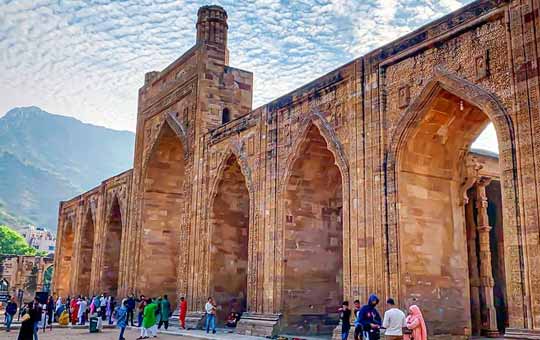Adhai Din Ka Jhonpra, one of the oldest mosques in India, stands as an architectural marvel in the historic city of Ajmer, Rajasthan. This magnificent structure, originally a Sanskrit college, was later converted into a mosque by Sultan Qutb-ud-Din Aibak in 1192 AD. It is an outstanding example of Indo-Islamic architecture, blending elements of Hindu, Jain, and Islamic styles. The name ‘Adhai Din Ka Jhonpra’, meaning ‘shed of two and a half days,’ has intrigued historians and travelers alike.
Historical Background
The origin of Adhai Din Ka Jhonpra is enveloped in multiple legends and historical records. Initially constructed as a Sanskrit learning center under the patronage of Vishnu Vardhan, the structure was a hub of education and knowledge. However, after the defeat of Prithviraj Chauhan at the hands of Muhammad Ghori, his general, Qutb-ud-Din Aibak, transformed the site into a mosque.
According to folklore, the name Adhai Din Ka Jhonpra comes from the belief that the mosque was built in just two and a half days. While this is likely an exaggeration, some historians suggest that an initial prayer hall was rapidly constructed within this short period. Others believe the name may have been derived from the duration of a religious fair held in the area.
Architectural Significance
The mosque is a splendid representation of Indo-Islamic architecture, incorporating elements from the remains of Hindu and Jain temples. The prayer hall, which serves as the main structure, is an open courtyard enclosed by intricately carved pillars and screens.
One of the most striking features of the mosque is its grand facade, adorned with Islamic calligraphy and intricate carvings. The arches of the mosque, with their pointed and horseshoe designs, reflect early Islamic architectural influences. The pillars, on the other hand, are distinctly Hindu and Jain in style, featuring floral and geometric motifs. These pillars, originally part of Hindu temples, were repurposed and integrated into the mosque’s design.
The mihrab (prayer niche), facing Mecca, is adorned with Arabic inscriptions, enhancing the spiritual ambiance of the mosque. The seven-arched wall, known for its delicate craftsmanship, showcases the mastery of artisans from the 12th century. Despite the passage of time, the structural integrity of the mosque remains largely intact, standing as a testament to the architectural prowess of the era.
Cultural and Religious Importance
While Adhai Din Ka Jhonpra is no longer an active place of worship, it continues to be a significant historical and cultural site. It symbolizes the transition of power from Hindu to Islamic rule in medieval India. The site attracts historians, architects, and tourists who admire its fusion of artistic styles and craftsmanship.
Ajmer itself is a city deeply intertwined with religious harmony. Located close to the renowned Ajmer Sharif Dargah of Khwaja Moinuddin Chishti, Adhai Din Ka Jhonpra holds a special place in the city’s heritage. Visitors often explore both these sites together, gaining insights into the rich historical layers of Ajmer.
Legends and Myths
There are several myths associated with Adhai Din Ka Jhonpra. Some believe that the mosque was miraculously constructed within two and a half days, leading to its unique name. Another legend suggests that the site was cursed, leading to its eventual disuse as a place of worship. While these stories add an air of mystery to the monument, historical evidence suggests a more gradual process of transformation and construction.
Tourist Information
Adhai Din Ka Jhonpra is located near the Ajmer Sharif Dargah, making it easily accessible for tourists. The best time to visit is between October and March, when the weather is pleasant. Entry is free, and visitors can explore the site daily between 6:00 AM and 7:00 PM.
